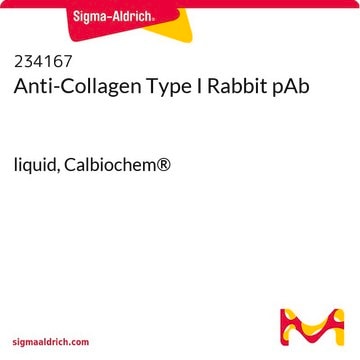05-1478
Anti-RUNX2 Antibody, clone AS110
clone AS110, from mouse
Sinonimo/i:
Acute myeloid leukemia 3 protein, CBF-alpha 1, Core-binding factor subunit alpha-1, Oncogene AML-3, Osteoblast-specific transcription factor 2, PEA2-alpha A, PEBP2-alpha A, Polyomavirus enhancer-binding protein 2 alpha A subunit, SL3-3 enhancer factor 1
About This Item
Prodotti consigliati
Origine biologica
mouse
Livello qualitativo
Forma dell’anticorpo
purified antibody
Tipo di anticorpo
primary antibodies
Clone
AS110, monoclonal
Reattività contro le specie
human
tecniche
immunocytochemistry: suitable
western blot: suitable
Isotipo
IgG2b
N° accesso NCBI
N° accesso UniProt
Condizioni di spedizione
wet ice
modifica post-traduzionali bersaglio
unmodified
Informazioni sul gene
human ... RUNX2(860)
Descrizione generale
Specificità
Immunogeno
Applicazioni
Epigenetics & Nuclear Function
Transcription Factors
Qualità
Western Blot Analysis:
Anti-RUNX2, clone AS110 detected RUNX at 1:1,000 to 1:2,000 dilution in HL-60 cell lysate resolved via SDS-PAGE and transferred to PVDF.
Descrizione del bersaglio
Stato fisico
Stoccaggio e stabilità
Handling Recommendations: Upon receipt, and prior to removing the cap, centrifuge the vial and gently mix the solution.
Altre note
Esclusione di responsabilità
Not finding the right product?
Try our Motore di ricerca dei prodotti.
Codice della classe di stoccaggio
12 - Non Combustible Liquids
Classe di pericolosità dell'acqua (WGK)
WGK 1
Punto d’infiammabilità (°F)
Not applicable
Punto d’infiammabilità (°C)
Not applicable
Certificati d'analisi (COA)
Cerca il Certificati d'analisi (COA) digitando il numero di lotto/batch corrispondente. I numeri di lotto o di batch sono stampati sull'etichetta dei prodotti dopo la parola ‘Lotto’ o ‘Batch’.
Possiedi già questo prodotto?
I documenti relativi ai prodotti acquistati recentemente sono disponibili nell’Archivio dei documenti.
Il team dei nostri ricercatori vanta grande esperienza in tutte le aree della ricerca quali Life Science, scienza dei materiali, sintesi chimica, cromatografia, discipline analitiche, ecc..
Contatta l'Assistenza Tecnica.








